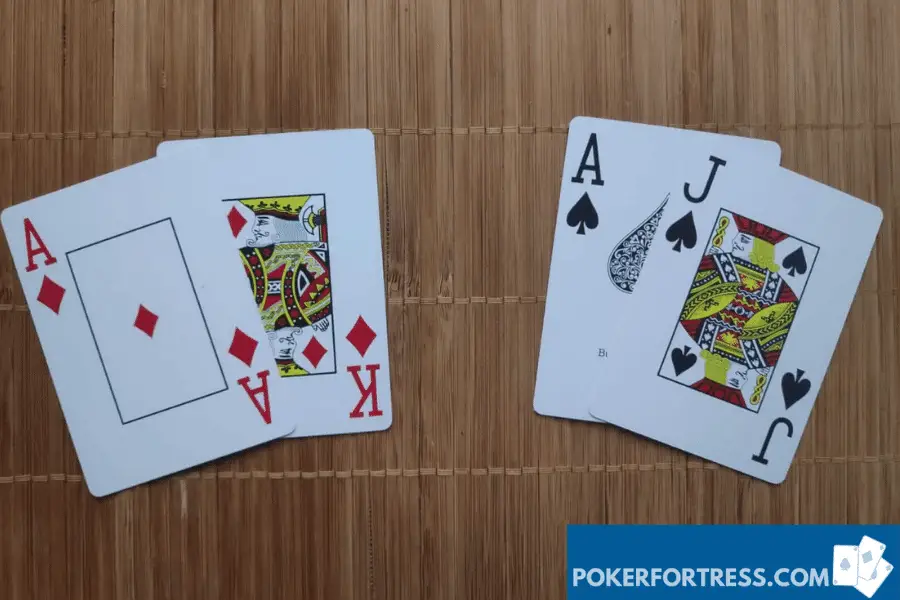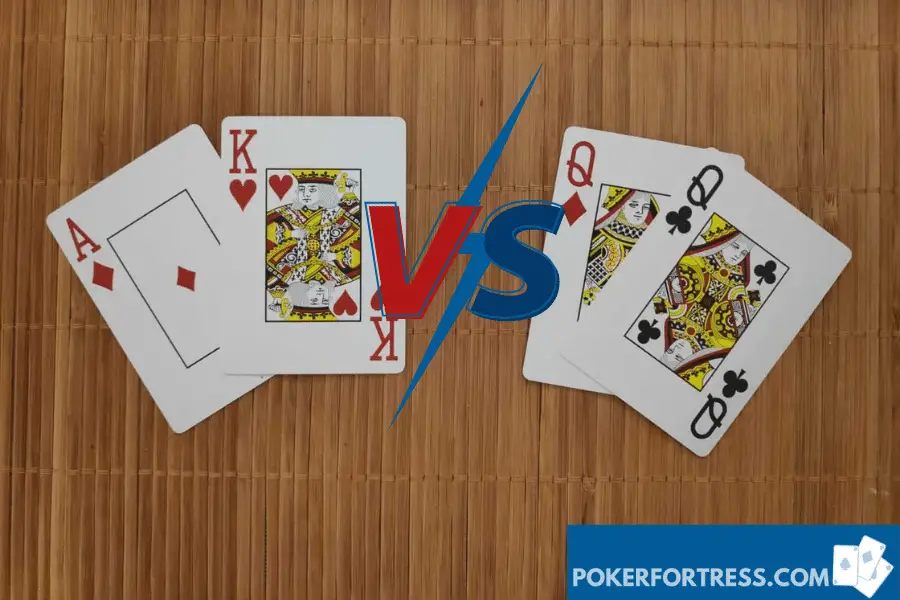Ace King Offsuit
Of the 169 possible starting hands in hold’em, a computer simulation shows that A-K offsuit is the fifth best possible. Only A-A, K-K, Q-Q, and A-K suited are rated higher.
When we hold an Ace in our hand it becomes less likely that our opponent holds Aces or Ace-King. Good equity against a calling range. Suited Ax will almost always have at least 35% equity against a 4-bet calling range. Solid playability. Suited wheel Ax hands have the ability to flop straight draws, pairs and of course the nut flush draw.
But if it doesn’t improve on the flop, it becomes an underdog against any player holding a pair — even a lowly pair of deuces. And with eight opponents at your table, there is a reasonable chance (about 40%) that one or more of your opponents has a pair after the flop.
If the river was an Ace or a King instead though, then this can be a good card to bluff against a weak/tight player who folds too much. I want to be very clear that you should never try to bluff the recreational poker players or even most of the regular players because they like to call too much at these stakes. In high-winning hands, an ace serves as the highest card of its suit (better than a king). In low-ranking hands, an ace serves as the lowest card of its suit (under the 2). After making this final declaration, the player receives into their hand the cards from the kitty (if one was used), and the player then discards an equal number of cards.
Two out of three times, you will not pair up the Ace or the King. A player with lowly pocket deuces is favored over you. With the turn and river still to come, it doesn’t look good for your A-K in the hole.
Nevertheless, many hold’em players treat it as if it was a made hand — one that could win at the showdown without further improvement. Raising preflop is a natural inclination. That was how I played it when I first started playing hold’em. But I soon learned from experience.
Sure, A-K in the hole, even unsuited, has great potential. Catch either an Ace or a King on the flop, you probably have top pair on the board with top kicker, putting your hand in the lead and quite likely to keep it all the way to the showdown, especially if there are no threats on the board such as three to a straight or a flush.
What’s Your Goal? It’s to win as many chips as possible when you catch a strong hand. Raising preflop is likely to thin the field, giving you a better chance of winning the pot. But it also cuts down on the potential pot size and gives warning to your opponents — like a tell. Then, on those occasions that the dealer puts another Ace or King on the board, if you bet out, it is likely to chase out the remaining players.
Consider the game texture. If it is a tight table, you won’t have much opportunity to build the pot. The only opponents staying in the pot at that point would likely be holding a strong hand, maybe a set or two-pair that beats you, or a strong draw, such as four to a flush or an open-ended straight draw. Danger!

Considering all these possibilities, since your goal is to win lots of chips when you make the best hand, it makes sense to limp along with your A-K before the flop. Then, when you do pair up your Ace or King, since you did not bet out or raise preflop, your bet on the flop is less likely to push out all your opponents. To your benefit, they are more inclined to chase.
When the flop doesn’t help your hand, which is twice as likely, you have a smaller investment and would lose less if an opponent catches a better hand. For example: suppose the flop is 8-9-10 offsuit, and a tight player raises the pot; you can be certain that the flop has really helped his hand — very likely a straight.
What happens when you and an opponent both connect? There will be times when you do connect on the flop to make a pair of Aces with a King kicker, or a pair of Kings with an Ace kicker. If an opponent has also connected to a pair of Aces, your kicker has him beat — and he’ll call you all the way to the showdown, adding substantially to your chip count.
Caution: If you do not pair your kicker but he does, your hand becomes second-best. Checking on the river may be your best decision.
Despite what some experts may say, logic tells us not to raise preflop with A-K in the hole. You are more likely to win a good pot — or lose less — by waiting to see what the flop brings. Then, take it from there.
Life/Poker Quote of the Week
“Don’t depend on good luck” — George “The Engineer” Epstein
You cannot control chance (luck), but you can influence it — both at the poker table and in your life.
Ace-King, especially when suited, is a very strong starting hand in No-Limit Holdem Poker. However, unless you connect with the board you will have only an ace-high hand to show down at the end. This makes playing ace-king problematic in some circumstances.
Ace King Off Suit
This article will look at some of the important no-limit Holdem strategy considerations when playing ace-king. These include your stack size, position at the table and the tendencies of opponents who are already in the pot, and those yet to act.
Basic ace-king strategy.
The worst possible outcome for ace-king is to be in a multi-way limped pot out of position and then to miss the flop. Under these circumstances the hand should usually be folded to any serious betting action from opponents.
Ace-King is a hand that you definitely do not want to be playing against multiple opponents.
Ace-king is in fact a drawing hand – you will usually need to improve to win a showdown. At the same time this hand has a strong likelihood of improving to become the best hand, any ace or king on the board will give you top pair with top kicker. This makes ace-king a hand to play strongly and positively until you encounter resistance, both before the flop and in later betting.
The ideal situation with this hand is that you take control before the flop by playing aggressive and positive poker. Raising, especially from position, will thin the field – ideally to a single opponent. If that opponent checks to you on the flop you will often be able to take the pot away from them with a continuation bet. When this gets called you have the added advantage of being able to see the river for free if your opponent checks to you after the turn.
You might like the multi-way cbetting video for strategy on dealing with tricky flops when facing 2 or more players. Hand 2 (3:22) and Hand 5 (12:36) use AK as examples.
Stack sizes and playing ace king.
The stack size of both you and opponents in the hand are a critical factor in playing ace-king. If the effective stacks (shortest stack in play) are small then your best move is often to get all-in before the flop with this hand. This is common in tournament situations and has two possible outcomes both of which are positive.
If you are up against small stacks, you should try and get all-in before the flop with ace king.
Either the pre-flop raiser (plus any caller) folds allowing you to take a good sized pot. Or if you are called – for example by a pair lower than Kings – you get to see all 5 board cards to improve your hand. This means you are only a little under 50% to win the hand – your pot equity will also be increased when there is blind money or a 3rd player who entered the pot then folded to your re-raise.
When you have a deep stack holding ace-king a pre-flop re-raise can give you valuable information on your opponent's hand. For example an opponent raises 3 times the big blind from middle position and you re-raise a total of 8 or 9 blinds from the button. When you're opponent is holding the hands you really fear – pocket aces or kings – he is likely to put in a re-raise here.
Be wary of 3-bets when you are deep stacked after making a re-raise with ace-king. This could very well mean that your opponent holds aces or kings.

Ace King Off Suit Is Called
However, pairs QQ and below and other ace-high hands are more likely to call. Not only have you defined your opponents hand, you have taken control of the hand before the flop – putting you in a position to take the pot away fairly often those times that you do miss the flop.
Player tendencies.

The tendencies of specific players, and indeed the table dynamic as a whole, will also affect the way that you play ace-king. Before the flop you may raise to isolate a particularly weak player seated to your right. However when a 'rock' in the same seat has entered the pot a flat call may be the best strategy – as such an opponent is more likely to tell you whether they liked the flop with their post-flop betting patterns.
Another opponent specific move occurs at a 'wild table' here you can flat call a raise from early position in the hope that a wild player later in the betting will re-raise, you can then push all-in over the top representing aces or kings. When called you still have very good equity against the wild player's range – in addition to the overlay of the dead money in the pot. Since ace-king does not play well in a multi-way pot caution is required with this move – you need to be sure that an opponent will re-raise ahead most of the time.

When the betting gets heavy ahead of you a good rule of thumb for playing ace-king, especially when not too deep stacked, is to be the player making the all-in bet and not the one calling this. Ace-king is almost 50% to win against pairs Q-Q and below and 30% to win against pocket Kings. However, when you are the player making the last big bet you have the added benefit of fold-equity. The chance that you're opponent may fold increasing the profit from playing this hand considerably.
How to play ace king evaluation.
Good no-limit Holdem play with ace-king involves all of the factors discussed above – but also and awareness of how they work together. For example a re-raise from position to define your opponents hand is only useful against a reasonably competent opponent, from position and with a deep stack.
Against a weaker opponent or with a short stack (15 blinds or less) your best move might be to push all-in immediately. The combination of 'fold equity' with your winning chances giving this play a positive expectation.
Ace King Off Suit
Go back to the awesome Texas Hold'em Strategy.
Acekingoffsuit Twitter
Comments